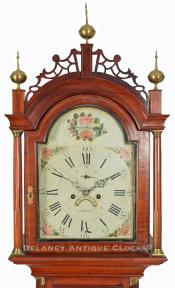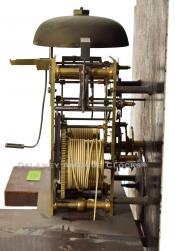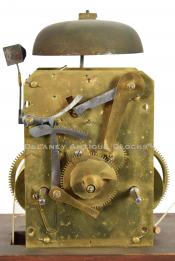Daniel Munroe, Concord, Massachusetts. An Inlaid mahogany case tall clock with a Daniel & Nathaniel Munroe label. 222151.
This attractive tall case clock features a painted dial signed by the Concord, MA, Clockmaker Daniel Munroe. It is an interesting example in that it retains the Daniel and Nathaniel Munroe label pasted on the waist door's inside. The inclusion of this label indicates that this tall clock was made between 1804 and 1807 when the partnership between the two brothers was active. Why the Daniel and Nathaniel partnership dials are signed by D. Munroe alone is a mystery to me. It seems Nathaniel was not as active in seeking attention for his work.
This is a superb example. The inlaid mahogany example features excellent narrow proportions. The format and construction of this case clearly illustrate the abilities of a very talented joiner. The woods selected are first-rate. The veneers are figured, and the 40-year-old finish highlights the grain-rich patterns. The base stands on four ogee bracket feet. These are applied to the bottom of the double-stepped molding located at the bottom of this base. The base panel is framed with a cross-banded border. Multiple line inlay patterns define the interior panel, which features an exuberantly grained selection of crotch veneer. The front corners of this waist are inset with brass stop-fluted quarter columns. These terminate in brass quarter capitals. The rectangularly shaped waist door is also cross-banded and lined inlaid in a borrowed pattern from the base section. The grain pattern selected for this location is special. An applied molding frames the outer edge of this door. This door opens to access the interior of the case. Inside, one will find the two tin can drive weights and the brass-faced pendulum bob. Posted on the back of the door is the Daniel & Nath'l Munroe label. This label reads in part, "WARRANTED / CLOCKS 7 TIME-PIECES / MADE BY / DANIEL & NATH'L MUNROE, AT THEIR / MANUFACTORY, CONCORD, (MASS.)." It states that a volume discount can be applied to purchases and that delivery within thirty miles of Concord is available. This is a fantastic addition to the history of the clock. The bonnet features traditional New England-style fretwork. Three inlaid and paneled finial plinths support the three ball and spike brass finials. Fully turned and fluted bonnet columns are stopped with brass rods. These columns are mounted in brass capitals and positioned on either side of the door. The two shaped columns located at the back of the bonnet are neatly fitted into the corners. The sides of the hood are fitted with tombstone-shaped sidelights. The arched bonnet door is veneered, lined inlaid, and fitted with glass. The dial mask is painted black, and the interior edge of this mask is trimmed with brass piping. The brass decoration here was added at an additional cost. The door opens to allow one access to the dial.
This painted iron dial measured 12 inches across and was manufactured and painted in Boston. The artwork is identifiable and is attributed to the Boston ornamental artist John Minot. This colorful artwork is well-executed, and this dial is signed Below the calendar "D. Munroe." The spandrels areas and the lunette are decorated with large floral patterns. These are framed with gilt-painted borders. The time track is formatted with Roman-style hour figures. A dotted minute ring separates these from the Arabic-style five-minute markers. The subsidiary seconds dial and month calendar are located in their traditional locations.
The works or movement is constructed in brass and is of good quality. Four-turned pillars support the two brass plates. Hardened steel shafts support the polished steel pinions and brass gearing. The winding drums are grooved. The escapement is a recoil. The movement is weight-driven and designed to run for eight days on a full wind. It is a two-train or a time-and-strike design having a rack and snail striking system. As a result, it will strike each hour on the hour on a cast iron bell mounted above the movement.
This clock was made circa 1806 and stands 7 feet 10 inches (94 inches) tall to the top of the center finial. The case is 19.75 inches wide and 9.75 inches deep when measured at the upper bonnet molding.
Inventory number 222151.




















